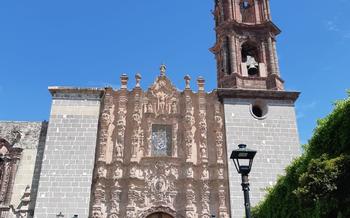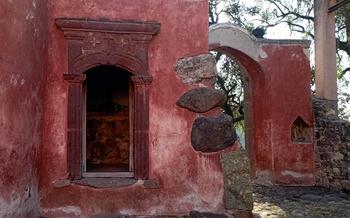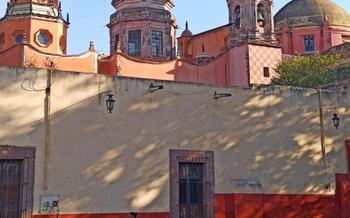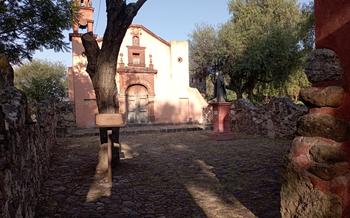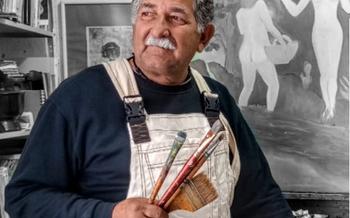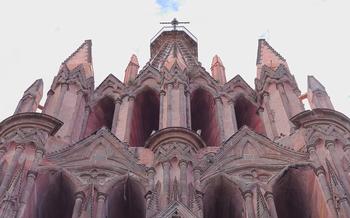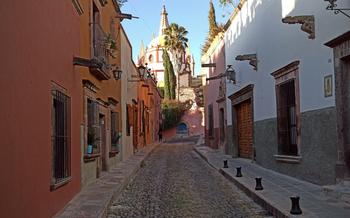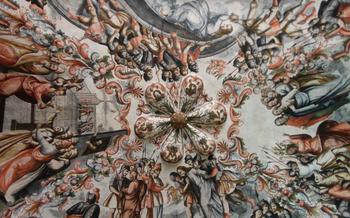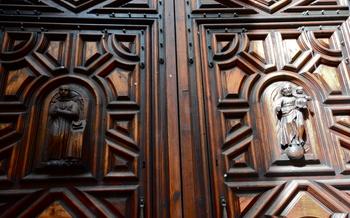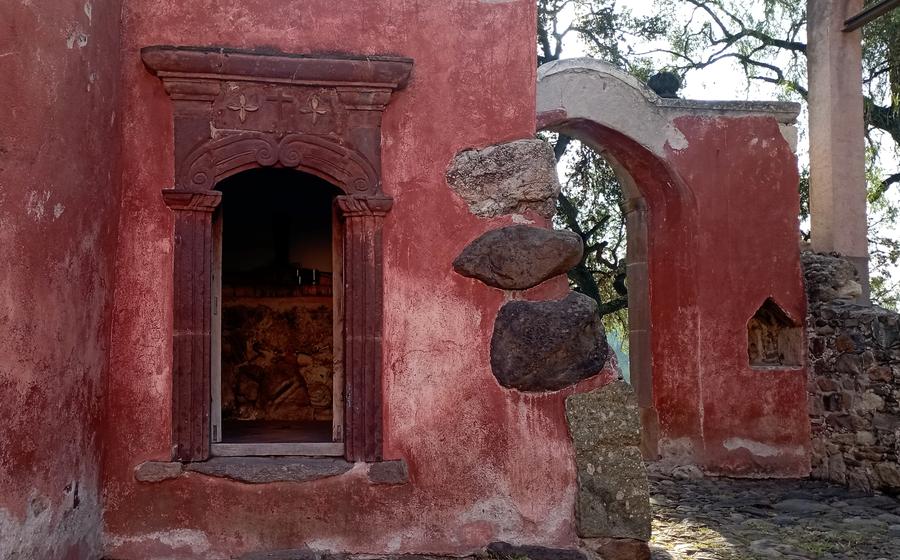
Templo de la Santa Cruz
- Accessibility
- Beyond the Facade:
- A Walk Through Time
- A Cultural Landmark
- A Peaceful Retreat
- A Local's Perspective
- Step Inside: Practical Information for Visitors
- A Journey of the Senses
- Capture the Moment: Preserving Memories through Photography and Videography
- An Architectural Masterpiece:
- Unveiling the Altars: A Journey Through Sacred Spaces
- A Thriving Community
- Insider Tip: Enhancing Your Experience
Accessibility
Situated in the heart of San Miguel de Allende, the Templo de la Santa Cruz is easily accessible to visitors. Its prime location on Calzada de la Presa, just a few steps from the Jardin Principal, makes it a convenient stop on any walking tour of the city. The church's central position ensures that it is well-connected by public transportation, with several bus routes passing nearby. Whether exploring the city on foot, by bicycle, or by taking a local bus, reaching the Templo de la Santa Cruz is a breeze.
Beyond the Facade:
Stepping through the grand entrance of the Templo de la Santa Cruz, visitors are greeted by an awe-inspiring spectacle of intricate ornamentation and devotional artistry. The interior is a fusion of Baroque splendor and Neoclassical elegance, a testament to the fusion of architectural styles that have shaped San Miguel de Allende's rich heritage.
The ceiling, a masterpiece of illusionistic painting, depicts scenes from the life of Christ and the Virgin Mary, creating the illusion of a celestial realm above. The walls are adorned with life-size sculptures of saints and angels, their serene expressions and meticulous detailing adding to the sacred ambiance of the space.
Notable among the artworks is the main altarpiece, a resplendent display of carved wood and gilded embellishments. It houses the revered image of the Santo Cristo de la Salud, the patron saint of San Miguel de Allende, whose story is intertwined with the city's history and beliefs.
The influence of Queretaro's Baroque style is evident in the Templo's exuberant ornamentation, with its twisting columns, intricate carvings, and lavish use of gold leaf. This architectural style, characterized by its theatrical extravagance, was a dominant force in the region during the colonial period, leaving an indelible mark on the city's religious and cultural landscape.
Over the centuries, the Templo de la Santa Cruz has witnessed countless stories and legends, passed down through generations of devout parishioners. From tales of miraculous interventions to stories of hidden treasures, the church has become a repository of the city's collective memory, a tangible link to its rich and vibrant past.
A Walk Through Time
The Templo de la Santa Cruz stands as a venerable witness to San Miguel de Allende's rich history, its presence intertwining with the city's evolution. In its early days, the church served as a significant spiritual center for the indigenous Otomi and Chichimeca communities, as well as Spanish settlers. Over time, it underwent various architectural transformations, reflecting the changing artistic styles that swept through the region.
In the 17th century, the Templo underwent a significant reconstruction, embracing the Baroque style prevalent in the nearby city of Queretaro. This renovation introduced intricate carvings, ornate embellishments, and a majestic dome, transforming the church into a showcase of Baroque splendor. The result is a harmonious blend of indigenous and European influences, a testament to the cultural diversity that has shaped San Miguel de Allende.
The Templo has borne witness to numerous historical events and personalities. It has played a pivotal role in the city's religious and civic life, hosting important celebrations, processions, and community gatherings. It has also provided refuge and solace during turbulent times, offering a sanctuary for those seeking spiritual comfort and guidance.
Despite the passage of time and the changing cityscape, the Templo de la Santa Cruz remains a steadfast symbol of San Miguel's enduring heritage. Its architectural grandeur, historical significance, and spiritual essence combine to create a space that transcends time, inviting visitors to embark on a journey through the city's vibrant past.
A Cultural Landmark
The Templo de la Santa Cruz transcends its religious significance and stands as a cultural landmark in San Miguel de Allende. It serves as a living museum, showcasing the city's rich artistic heritage and embodying the fusion of Spanish and Mexican influences. The Templo's walls have borne witness to countless exhibitions and cultural events, celebrating the city's vibrant artistic spirit.
Collaborations with art and cultural institutions have transformed the church into a dynamic platform for artistic expression. Local and international artists have showcased their works within the hallowed halls, adding a contemporary dimension to the Templo's centuries-old charm. This synergy between history and modernity has positioned the Templo as a cultural hub, attracting art enthusiasts from around the globe.
The recognition by UNESCO as a World Heritage Site further cements the Templo's status as a cultural treasure. This prestigious designation underscores the Templo's exceptional universal value and its profound contribution to the world's cultural heritage. Preservation efforts spearheaded by local authorities and international organizations are tirelessly undertaken to ensure the Templo's legacy endures for generations to come.
A Peaceful Retreat
Amidst the vibrant energy and lively atmosphere of San Miguel de Allende, the Templo de la Santa Cruz stands as a tranquil oasis, inviting visitors to seek solace and reflection within its sacred walls. Step inside this architectural masterpiece, and you'll be enveloped by a sense of serenity that transcends the bustling city outside. The soft glow of flickering candles illuminates the intricate details of the church's interior, casting a warm and inviting ambiance.
Take a moment to pause and appreciate the peaceful atmosphere that permeates the Templo. Let the gentle sounds of church bells and chanting wash over you, creating a harmonious soundtrack for your contemplation. The cool stone walls and worn pews offer a tactile reminder of the Templo's rich history, while the soft aroma of incense and candles fills the air with a sense of reverence.
Whether you're seeking a moment of solitude or a deeper connection with your spiritual side, the Templo de la Santa Cruz provides an ideal sanctuary for reflection and prayer. Find a quiet corner to sit and meditate, or simply allow the peaceful surroundings to soothe your mind and spirit. In this sacred space, you'll discover a sense of tranquility that will stay with you long after your visit.
A Local's Perspective
To fully grasp the essence of the Templo de la Santa Cruz, it's essential to seek the insights of those who have a deep connection with it. Locals, especially long-time residents or historians, possess a wealth of knowledge and personal stories that can enrich your understanding of the church's significance.
Engage in conversations with locals to uncover their personal anecdotes about the Templo. Inquire about their childhood memories, stories of religious celebrations, or any unique experiences they've had within its walls. Listen attentively to their perspectives, as they often hold a profound understanding of the church's role in the community's past and present.
One local resident, Señora Maria, shared her fond memories of attending Sunday mass at the Templo as a child. She described the vibrant atmosphere, the melodious choir, and the sense of community that permeated the church. She spoke of the annual feast day celebrations, where the entire town would come together to honor the patron saint with music, dancing, and traditional food.
By engaging with locals, you can gain a deeper appreciation for the Templo de la Santa Cruz, not just as a historical landmark, but as a living, breathing part of San Miguel de Allende's cultural fabric. Their stories and insights will add a personal touch to your experience, making your visit to the church all the more meaningful.
Step Inside: Practical Information for Visitors
Before embarking on your exploration of the Templo de la Santa Cruz, it's essential to be aware of some practical information that will enhance your visit.
Admission and Visiting Hours:
- Entry to the Templo de la Santa Cruz is free of charge for all visitors.
- The Templo's doors are generally open to the public from 8:00 AM to 8:00 PM daily.
Dress Code and Etiquette:
- While there is no strict dress code, visitors are encouraged to dress respectfully, covering their shoulders and knees.
- Silence and reverence are maintained inside the church, and visitors are requested to be mindful of their behavior.
Guided Tours and Self-Guided Exploration:
- Guided tours are not typically offered for the Templo de la Santa Cruz, allowing visitors to explore at their own pace.
- Informative brochures and pamphlets are available at the entrance, providing insights into the church's history and architecture.
- For a more in-depth understanding, consider engaging the services of a local guide who can share anecdotes and stories about the Templo.
A Journey of the Senses
The Templo de la Santa Cruz engages the senses in a multitude of ways. Its architectural beauty is a feast for the eyes, with its intricate facade, dramatic arches, and soaring dome. The intricate carvings and sculptures that adorn the exterior and interior of the church invite closer examination, revealing hidden details and symbolism.
The sounds of the Templo are equally captivating. The rhythmic ringing of church bells echoes through the neighborhood, calling the faithful to prayer. Inside, the melodious chanting of priests and the soft murmur of worshippers create a serene and spiritual atmosphere. The flickering flames of candles cast a warm glow, illuminating the sacred space and adding to the ambiance.
The aromas of the Templo are a blend of incense, beeswax, and fresh flowers. The sweet scent of incense fills the air, creating a sense of peace and tranquility. The beeswax candles emit a warm, honeyed aroma, adding to the sacred atmosphere. Fresh flowers, often offered as offerings to the saints, contribute their delicate fragrance to the mix, creating a heady and intoxicating scent.
The tactile sensation of the Templo's stone walls and pews invites visitors to connect with the physicality of the space. The cool, rough texture of the stone walls provides a contrast to the smooth, polished wood of the pews. The worn patina of the surfaces speaks to the passage of time and the countless worshippers who have passed through these doors.
Capture the Moment: Preserving Memories through Photography and Videography
The Templo de la Santa Cruz presents a captivating spectacle, inviting visitors to capture its beauty through photography and videography. While documenting your experience, it's essential to respect the sacredness of the church and adhere to specific guidelines. Photography and videography are generally permitted within the church, but using flash photography is prohibited to preserve the integrity of the artwork and decorations.
To capture unique perspectives and details, explore different angles and vantage points within the church. The intricate carvings on the altarpieces, the vibrant colors of the stained glass windows, and the serene atmosphere create an ideal backdrop for stunning photographs. If you wish to capture the church's acoustics, consider recording the melodious sounds of the church bells or the harmonious chanting during religious services.
Remember to be mindful of other visitors and avoid disrupting ongoing religious ceremonies or services. When sharing your images online, it's crucial to credit the Templo de la Santa Cruz appropriately and adhere to any copyright or usage restrictions. By respecting these guidelines, you can preserve your memories while contributing to the preservation and appreciation of this architectural masterpiece.
An Architectural Masterpiece:
The Templo de la Santa Cruz stands as a testament to the artistic and architectural heritage of San Miguel de Allende. Its unique features, deeply rooted in the Spanish Colonial Baroque style, make it an architectural masterpiece. The facade boasts intricate carvings, columns, and arches that create a sense of grandeur and elegance. The intricate designs adorning the exterior are a testament to the skill and dedication of the artisans who worked on this sacred space.
The interior of the Templo is equally impressive, showcasing a series of barrel vaults that add depth and dimension to the space. The intricate details and symbolism found throughout the architecture reveal the deep religious beliefs and cultural influences that shaped the construction of this sacred site.
Unveiling the Altars: A Journey Through Sacred Spaces
The Templo de la Santa Cruz boasts a stunning array of altars, each a testament to the artistry and devotion of its creators. The main altar, or retablo mayor, is a masterpiece of Baroque design, reaching towards the heavens with its intricate carvings and gilded details. The intricate and storied imagery on the altarpiece depicts scenes from the life of Christ, the Virgin Mary, and various saints, inviting the faithful to contemplate their stories and seek divine guidance.
The smaller altars, or retablos, are equally captivating, each dedicated to a specific saint or devotion. These altars showcase the diverse spiritual traditions of the community, honoring beloved figures such as the Virgin of Guadalupe, Saint Anthony, and Saint Francis of Assisi. The detailed paintings, sculptures, and ornamentation on these altars create a sense of intimacy and devotion, allowing visitors to connect with the saints and seek their intercession.
The intricate and delicate nature of these altars highlights the skill and craftsmanship of the artisans who created them. Each altar is a unique work of art, reflecting the deep faith and cultural heritage of San Miguel de Allende. Through these altars, visitors can gain a deeper appreciation for the city's rich spiritual history and the artistry that continues to thrive within its walls.
A Thriving Community
The Templo de la Santa Cruz is deeply embedded in the fabric of San Miguel de Allende's community. It serves as a spiritual and cultural hub, playing a vital role in the daily lives of the locals. The church is frequently used for religious ceremonies, such as baptisms, weddings, and funerals, bringing together families and friends to celebrate important milestones.
Beyond its religious significance, the Templo also serves as a venue for community events and initiatives. It often hosts concerts, art exhibitions, and cultural performances, showcasing the city's vibrant artistic scene. The church also collaborates with local organizations to provide educational and social programs, such as workshops, food drives, and community service activities.
The Templo's commitment to the community extends beyond its physical walls. It actively participates in charitable work, supporting local charities and non-profit organizations that provide assistance to the needy. The church's involvement in these initiatives reflects its dedication to fostering a compassionate and supportive community.
As a symbol of unity and resilience, the Templo de la Santa Cruz stands tall, embodying the spirit of San Miguel de Allende. It is a place where people come together to celebrate, mourn, learn, and grow, strengthening the bonds that unite this vibrant community.
Insider Tip: Enhancing Your Experience
For an unparalleled experience, visit the Templo de la Santa Cruz during the early morning hours, when the city is still slumbering. Bathed in the warm glow of the rising sun, the Templo exudes a serene tranquility that allows for deep contemplation and reflection. Take this opportunity to savor the intricate details of the facade without the distractions of crowds. Afterward, indulge in a delightful breakfast at one of the charming local cafes nearby, where you can savor the flavors of San Miguel while basking in the contentment of your visit.
As you stroll back to the Templo, take a moment to explore the hidden corner behind the church, where you'll discover a tranquil garden adorned with colorful flowers and a calming fountain. This serene oasis offers a welcome respite from the bustling city, inviting you to linger and soak in the peaceful atmosphere. Embrace this opportunity to find solace amidst the vibrant energy of San Miguel de Allende.
